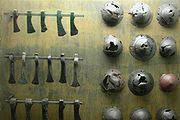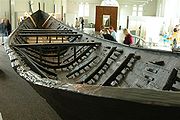
Nydam Mose
Encyclopedia

Sundeved
Until January 1, 2007 Sundeved was a municipality in the former South Jutland County on the east coast of the Jutland peninsula in south Denmark. The municipality covered an area of 69 km², and had a total population of 5,298...
, eight kilometres from Sønderborg
Sønderborg
Sønderborg Municipality , is a municipality in Region of Southern Denmark partially on the Jutland peninsula and partially on the island of Als in south Denmark, at the border with Germany. The municipality covers an area of , and has a total population of 76,236...
, Denmark
Denmark
Denmark is a Scandinavian country in Northern Europe. The countries of Denmark and Greenland, as well as the Faroe Islands, constitute the Kingdom of Denmark . It is the southernmost of the Nordic countries, southwest of Sweden and south of Norway, and bordered to the south by Germany. Denmark...
.
History
In the Iron AgeIron Age
The Iron Age is the archaeological period generally occurring after the Bronze Age, marked by the prevalent use of iron. The early period of the age is characterized by the widespread use of iron or steel. The adoption of such material coincided with other changes in society, including differing...
. the site of the bog was a sacred lake, where the weapons and ships of vanquished armies were offered to the indigenous gods
Germanic paganism
Germanic paganism refers to the theology and religious practices of the Germanic peoples of north-western Europe from the Iron Age until their Christianization during the Medieval period...
in thanks for victory over the fallen enemy. Many items were deliberately destroyed (broken or hacked into pieces) in ritual sacrificial acts, from the period 200 to 400AD. Nydam Bog has played a role in the Danish national claim for Southern Jutland
Southern Jutland
Southern Jutland is the name for the region south of the Kongeå in Jutland, Denmark. The region north of the Kongeå is called Nørrejylland . Both territories had their own ting assemblies in the Middle Ages . South Jutland is mentioned for the first time in the Knýtlinga saga.In the 13th century...
.
The first known finds from the bog date from the 1830s, when a local farmer gave old swords and shields as toys to his children.
Amongst numerous other items, three boats were found in Nydam Bog. In particular, the 23 metre long oak boat, commonly known as "the Nydam Boat", maintains a distinguished position amongst Danish Iron Age finds, as it is the oldest known rowing vessel in Northern Europe
Northern Europe
Northern Europe is the northern part or region of Europe. Northern Europe typically refers to the seven countries in the northern part of the European subcontinent which includes Denmark, Estonia, Latvia, Lithuania, Norway, Finland and Sweden...
. The oak (egetræsbåden) boat is on display at the archaeological museum in Gottorp Castle
Gottorp
Gottorf Castle is a castle and estate in the city of Schleswig, Schleswig-Holstein, Germany. It is the ancestral home of the Holstein-Gottorp branch of the House of Oldenburg...
, Schleswig, Germany
Germany
Germany , officially the Federal Republic of Germany , is a federal parliamentary republic in Europe. The country consists of 16 states while the capital and largest city is Berlin. Germany covers an area of 357,021 km2 and has a largely temperate seasonal climate...
.
Excavation

First excavation
From 1859 to 1863, archaeologist Conrad Engelhardt excavated the bog. Engelhardt found weapons, tools, pieces of clothing and two intact clinker built boats, one made of oak and one made of pine. The weapons include lanceLance
A Lance is a pole weapon or spear designed to be used by a mounted warrior. The lance is longer, stout and heavier than an infantry spear, and unsuited for throwing, or for rapid thrusting. Lances did not have tips designed to intentionally break off or bend, unlike many throwing weapons of the...
s, spear
Spear
A spear is a pole weapon consisting of a shaft, usually of wood, with a pointed head.The head may be simply the sharpened end of the shaft itself, as is the case with bamboo spears, or it may be made of a more durable material fastened to the shaft, such as flint, obsidian, iron, steel or...
s, bows
Bow (weapon)
The bow and arrow is a projectile weapon system that predates recorded history and is common to most cultures.-Description:A bow is a flexible arc that shoots aerodynamic projectiles by means of elastic energy. Essentially, the bow is a form of spring powered by a string or cord...
, arrow
Arrow
An arrow is a shafted projectile that is shot with a bow. It predates recorded history and is common to most cultures.An arrow usually consists of a shaft with an arrowhead attached to the front end, with fletchings and a nock at the other.- History:...
s and round shield
Shield
A shield is a type of personal armor, meant to intercept attacks, either by stopping projectiles such as arrows or redirecting a hit from a sword, mace or battle axe to the side of the shield-bearer....
s. Under these finds were the remains of a third boat, which apparently had been demolished already during the sacrifice.
Engelhardt’s work ceased with the outbreak of the Second Schleswig War in early 1864. Some of the discoveries from the bog were lost during the Second Schleswig War. The smaller of the two boats, perhaps 19 meters long and made of pine, was hacked up and used as firewood by troops.
Second excavation
The National Museum of DenmarkNational Museum of Denmark
The National Museum of Denmark in Copenhagen is Denmark’s largest museum of cultural history, comprising the histories of Danish and foreign cultures, alike. The museum's main domicile is located a short distance from Strøget at the center of Copenhagen. It contains exhibits from around the world,...
resumed excavation of the bog in 1989. During excavation a large quantity of weapons have come to light, in the form of swords, spears, bows and arrows; and also personal effects such as belt buckles, brooches and ornate clasps. These finds originate from the Iron Age, in the period between 250 and 550.
Nydam Boat


Nydam Society
Interest in the archaeology of Nydam Bog has always been particularly lively in the local area. The Nydam discoveries were and remain a significant theme in the relationship between Danish and German cultures in the border region. On this basis, the "Society for Nydam Research" – commonly known as the Nydam Society - was formed in 1983. Through its work, this interest group has contributed to the resumption of National Museum of Denmark’s investigation of the bog.Today, the site is a green meadow. Parking is available on Nydamvej. From here, there is a path (Nydamstien) to the small white house, Nydamhuset, which is situated beside the site of the archaeological discoveries. It takes about 10 minutes to walk there.
The Nydam Society's long-standing desire to build a copy of the Nydam Boat is being realized. The boat will be built employing the techniques of the time – both to exploit the material characteristics of the timber and to develop an understanding of how large vessels were built in that period. Construction of a copy of the Nydam Boat will be based on the oak boat found in 1859. The construction of the Nydam Boat is divided into two phases. Phase 1 is feasibility study to investigate the construction of the boat. Here the builders will investigate prerequisites and gather experience for use in Phase 2, which comprises building the complete boat.

